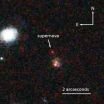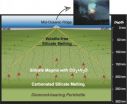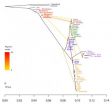(Press-News.org) What if you had a "Wayback Television Set" and could watch an entire month of ancient prehistory unfold before your eyes in real time? David Rubin of the U.S. Department of Energy's Lawrence Berkeley National Laboratory (Berkeley Lab) presented just such a scenario to the American Astronomical Society (AAS) meeting in Long Beach, CA, when he announced the discovery of a striking astronomical object: a Type Ia supernova with a redshift of 1.71 that dates back 10 billion years in time. Labeled SN SCP-0401, the supernova is exceptional for its detailed spectrum and precision color measurement, unprecedented in a supernova so distant.
"This is the most distant supernova anyone has ever found for doing dependable cosmology," says Rubin, a member of the international Supernova Cosmology Project (SCP) based at Berkeley Lab. "The most important unanswered question we have about the nature of dark energy is whether it varies over time – whether it affects the expansion of the universe differently in different eras. With SN SCP-0401, we have the first example of a well-measured supernova sufficiently far away to study the expansion history of the universe from almost 10 billion years ago."
The SCP is headed by astrophysicist Saul Perlmutter, a faculty senior scientist in Berkeley Lab's Physics Division and a professor of physics at the University of California, Berkeley, who puts it this way: "Imagine you're channel surfing and you come across live news coverage of an exploding star – and then you see the dateline that says it's July 22nd, 9,947,989,219 BCE. By August 9 the supernova is at its brightest and starts to fade, but you get to watch the whole thing – even though, before the news could ever reach your TV, our solar system had to form, and then our planet, and intelligent life had to evolve on Earth."
Live-at-the-scene coverage has special advantages. While the light curves of most supernovae with redshifts above 1.5 are either incomplete or not cosmologically useful, because their colors can't be accurately measured, our imaginary Wayback TV broadcast, says Perlmutter, "has enough high-resolution information to allow us to confidently compare this ancient supernova with much more recent astronomical events."
Wayback TV is imaginary, but not SN SCP-0401's high-resolution details. The SCP's analysis of the new supernova will appear in the January 20, 2013 issue of the Astrophysical Journal.
Most supernovae begin as stars whose cores collapse, but a Type Ia supernova, in the simplest model, begins as a white dwarf star borrowing mass from a companion star; when it reaches critical mass, it erupts in a titanic thermonuclear explosion. While not identical, Type Ia's are more similar in brightness than any other type of supernova, and their variability can be accurately corrected for comparison.
This makes them excellent "standard candles" for measuring cosmic distances – the dimmer they appear, the farther away they are, and their distance can be confidently measured. At the same time, their redshift is a direct gauge of how much the universe has expanded since the supernova exploded.
Measuring the history of expansion ultimately depends on comparing distance and redshift for enough Type Ia's over a long expanse of time; this is how accelerating expansion, propelled by dark energy, was independently found by two competing teams and announced in 1998. For this discovery, in 2011 Saul Perlmutter divided the Nobel Prize in Physics with Brian Schmidt and Adam Riess of the competing High-z Supernova Search Team.
The new supernova Rubin announced at the AAS meeting was first spotted in a supernova survey conducted by the Supernova Cosmology Project using the Hubble Space Telescope (HST) in 2004, part of a scheduling sequence in which the two teams shared alternate scans of the sky.
"We were looking for supernovae so far away that they really required the HST, not just to detect them but so we could separate them from their host galaxies, in hopes of getting clean spectra," says Rob Knop, now of Quest University Canada, who headed the SCP's search strategy in 2004 and wrote the software that identified likely candidates. Following an SCP tradition of nicknaming candidates after composers, Knop and colleague Rachel Gibbons, both then at Vanderbilt University, named the new contender "Mingus" after the jazz composer.
A needle in a haystack far, far away
Mingus was so distant it skirted the edge of invisibility, like trying to see a firefly all the way across the United States. And it was red – possibly its intrinsic color but more likely due to very high redshift; only with an accurate spectrum could the researchers tell for sure.
Initial spectra were captured by the Hubble's Advanced Camera for Surveys (ACS), equipped with a grism (a combined diffraction grating and prism) that collects light from the target object and from nearby objects as well.
"The ACS grism data suggested the most likely match was a Type Ia supernova at redshift 1.7 – very distant and very old – but by itself the ACS could not establish the spectral features which could confirm this," says SCP member Andrew Fruchter, of the Space Telescope Science Institute.
The problem was solved when a different grism-equipped camera, the Wide Field Camera 3 (WFC3), was installed on the Hubble in 2009. When David Rubin saw the data he realized that the WFC3 had luckily caught some of the spectrum of Mingus's host galaxy.
Fruchter says, "The new WFC3 data pinned down the host's redshift at 1.713 – a match to the first estimate for Mingus." He adds that "each new instrument on HST has enabled new discoveries. It's exciting to see the Hubble continue to make breakthroughs even as we are building its successor."
To confirm that far-away Mingus really was a Type Ia, Rubin derived a spectrum model that allowed him to compare its spectrum with published spectra from other Type Ia's, as well as from core-collapse supernovae, as these objects would appear at redshift 1.713. The best-fit Type Ia spectrum was an almost perfect match with Mingus's spectrum. With Rubin's model indicating an over 90-percent chance of its identity – a conservative estimate, at that – Mingus was confirmed as a Type Ia and with confirmation got its more official-sounding designation, SCP-0401.
"To be able to directly compare different Type Ia supernovae, we have to fit their light curves – the time it takes the supernova to reach maximum brightness and the time it takes that brightness to fall off," says Rubin. "We also have to be able to compare the brightness of the different colors during this process, in order to calibrate the supernova."
Perlmutter remarks that such calibration "can be a lot like trying to match a particular shade of housepaint when you've got a thousand color chips to compare, maybe more." In this case, calibration meant finding exactly the right shade of red. Both the ACS camera and the Near Infrared Camera and Multi-Object Spectrometer (NICMOS), also carried aboard the Hubble, measured SCP-0401's apparent brightness in different colors over time.
The cosmological picture from SCP-0401, a single distant data point, begins to sharpen our measurements of dark energy's possible time variation. This is the first step toward the precision measurements that will require observations of many more Type Ia supernovae as far away as SCP-0401.
Says Rubin, "Hubble is our best bet to find and measure similar distant supernovae. Luckily Hubble has a few good years left."
INFORMATION:
"Precision measurement of the most distant spectroscopically confirmed supernova Ia with the Hubble Space Telescope," by David Rubin, Rob Knop, Eli Rykoff, Greg Aldering, Rahman Amanullah, Kyle Barbary, M. Shane Burns, Alex Conley, Natalia Connolly, Susana Deustua, Vitaliy Fadeyev, Hannah Fakhouri, Andrew Fruchter, Rachel Gibbons, Gerson Goldhaber (deceased), Ariel Goobar, Eric Hsiao, Xiaosheng Huang, Marek Kowalski, Chris Lidman, Josh Meyers, Jakob Nordin, Saul Perlmutter, Anthony Spadafora, and Vallery Stanishev – The Supernova Cosmology Project – will appear in the January 20, 2013 issue of the Astrophysical Journal and is currently available as a preprint on arXiv at http://arxiv.org/abs/1205.3494. This work was supported by the U.S. Department of Energy's Office of Science.
Lawrence Berkeley National Laboratory addresses the world's most urgent scientific challenges by advancing sustainable energy, protecting human health, creating new materials, and revealing the origin and fate of the universe. Founded in 1931, Berkeley Lab's scientific expertise has been recognized with 13 Nobel prizes. The University of California manages Berkeley Lab for the U.S. Department of Energy's Office of Science. For more, visit www.lbl.gov.
DOE's Office of Science is the single largest supporter of basic research in the physical sciences in the United States, and is working to address some of the most pressing challenges of our time. For more information, please visit the Office of Science website at science.energy.gov/.
The farthest supernova yet for measuring cosmic history
Berkeley Lab-based Supernova Cosmology Project uses Hubble Space Telescope data to discover the most distant well-measured Type Ia supernova ever found
2013-01-10
ELSE PRESS RELEASES FROM THIS DATE:
Spin and bias in published studies of breast cancer trials
2013-01-10
Spin and bias exist in a high proportion of published studies of the outcomes and adverse side-effects of phase III clinical trials of breast cancer treatments, according to new research published in the cancer journal Annals of Oncology [1] today (Thursday).
In the first study to investigate how accurately outcomes and side-effects are reported in breast cancer trials, researchers at the Princess Margaret Cancer Centre and University of Toronto (Toronto, Canada) found that in a third of all trials that failed to show a statistically significant benefit for the treatment ...
Particles of crystalline quartz wear away teeth
2013-01-10
This press release is available in German.
Dental microwear, the pattern of tiny marks on worn tooth surfaces, is an important basis for understanding the diets of fossil mammals, including those of our own lineage. Now nanoscale research by an international multidisciplinary group that included members of the Max Planck Institute for Evolutionary Anthropology in Leipzig has unraveled some of its causes. It turns out that quartz dust is the major culprit in wearing away tooth enamel. Silica phytoliths, particles produced by plants, just rub enamel, and thus have ...
First image of insulin 'docking' could lead to better diabetes treatments
2013-01-10
A landmark discovery about how insulin docks on cells could help in the development of improved types of insulin for treating both type 1 and type 2 diabetes.
For the first time, researchers have captured the intricate way in which insulin uses the insulin receptor to bind to the surface of cells. This binding is necessary for the cells to take up sugar from the blood as energy.
The research team was led by the Walter and Eliza Hall Institute and used the Australian Synchrotron in Melbourne, Australia. The study was published today in the journal Nature.
For more ...
Magma in mantle has deep impact
2013-01-10
HOUSTON – (Jan. 9, 2013) – Magma forms far deeper than geologists previously thought, according to new research at Rice University.
A group led by geologist Rajdeep Dasgupta put very small samples of peridotite under very large pressures in a Rice laboratory to determine that rock can and does liquify, at least in small amounts, as deep as 250 kilometers in the mantle beneath the ocean floor. He said this explains several puzzles that have bothered scientists.
Dasgupta is lead author of the paper to be published this week in Nature.
The mantle is the planet's middle ...
After decades of research, scientists unlock how insulin interacts with cells
2013-01-10
The discovery of insulin nearly a century ago changed diabetes from a death sentence to a chronic disease.
Today a team that includes researchers from Case Western Reserve University School of Medicine announced a discovery that could lead to dramatic improvements in the lives of people managing diabetes.
After decades of speculation about exactly how insulin interacts with cells, the international group of scientists finally found a definitive answer: in an article published today in the journal Nature, the group describes how insulin binds to the cell to allow the ...
GW researchers find variation in foot strike patterns in predominantly barefoot runners
2013-01-10
WASHINGTON –A recently published paper by two George Washington University researchers shows that the running foot strike patterns vary among habitually barefoot people in Kenya due to speed and other factors such as running habits and the hardness of the ground. These results are counter to the belief that barefoot people prefer one specific style of running.
Kevin Hatala, a Ph.D. student in the Hominid Paleobiology doctoral program at George Washington, is the lead author of the paper that appears in the recent edition of the journal Public Library of Science, or PLOS ...
A history lesson from genes
2013-01-10
When Charles Darwin first sketched how species evolved by natural selection, he drew what looked like a tree. The diagram started at a central point with a common ancestor, then the lines spread apart as organisms evolved and separated into distinct species.
In the 175 years since, scientists have come to agree that Darwin's original drawing is a bit simplistic, given that multiple species mix and interbreed in ways he didn't consider possible (though you can't fault the guy for not getting the most important scientific theory of all time exactly right the first time). ...
Study examines how news spreads on Twitter
2013-01-10
Nearly every major news organization has a Twitter account these days, but just how effective is the microblogging website at spreading news? That's the question University of Arizona professor Sudha Ram set out to answer in a recent study of a dozen major news organizations that use the social media website as one tool for sharing their content.
The answer, according to Ram's research, varies widely by news agency, and there may not be one universally applicable strategy for maximizing Twitter effectiveness. However, news agencies can learn a lot by looking at how their ...
Unnecessary antimicrobial use increases risk of recurrent infectious diarrhea
2013-01-10
The impact of antibiotic misuse has far-reaching consequences in healthcare, including reduced efficacy of the drugs, increased prevalence of drug-resistant organisms, and increased risk of deadly infections. A new study featured in the February issue of Infection Control and Hospital Epidemiology, the journal of the Society for Healthcare Epidemiology of America, found that many patients with Clostridium difficile infection (C. difficile) are prescribed unnecessary antibiotics, increasing their risk of recurrence of the deadly infection. The retrospective report shows ...
Flooding preparedness needs to include infection prevention and control strategies
2013-01-10
Flooding can cause clinical and economic damage to a healthcare facility, but reopening a facility after extensive flooding requires infection prevention and control preparedness plans to ensure a safe environment for patients and healthcare workers. In a study published in the February issue of Infection Control and Hospital Epidemiology, the journal of the Society for Healthcare Epidemiology of America, clinical investigators report key findings and recommendations related to the closure and re-opening of hospitals impacted by black-water floods. The guidance builds on ...
LAST 30 PRESS RELEASES:
NTP-enhanced lattice oxygen activation in Ce-Co catalysts for low-temperature soot combustion
Synergistic interface engineering in Cu-Zn-Ce catalysts for efficient CO2 hydrogenation to methanol
COVID-19 leaves a lasting mark on the human brain
Scientists use ultrasound to soften and treat cancer tumors without damaging healthy tissue
Community swimming program for Black youth boosts skills, sense of belonging, study finds
Specific depressive symptoms in midlife linked to increased dementia risk
An ‘illuminating’ design sheds light on cholesterol
Who is more likely to get long COVID?
Study showcases resilience and rapid growth of “living rocks”
Naval Research Lab diver earns Office of Naval Research 2025 Sailor of the Year
New Mayo-led study establishes practical definition for rapidly progressive dementia
Fossil fuel industry’s “climate false solutions” reinforce its power and aggravate environmental injustice
Researchers reveal bias in a widely used measure of algorithm performance
Alcohol causes cancer. A study from IOCB Prague confirms damage to DNA and shows how cells defend against it
Hidden viruses in wastewater treatment may shape public health risks, study finds
Unlock the power of nature: how biomass can transform climate mitigation
Biochar reshapes hidden soil microbes that capture carbon dioxide in farmland
Reducing saturated fat intake shows mortality benefit, but only in high-risk individuals
Manta rays create mobile ecosystems, study finds
Study: Mixed results in using lipoic acid to treat progressive multiple sclerosis
Norbert Holtkamp appointed director of Fermi National Accelerator Laboratory
New agentic AI platform accelerates advanced optics design
Biologists discover neurons use physical signals — not electricity — to stabilize communication
Researchers discover that a hormone can access the brain by hitchhiking
University of Oklahoma researcher awarded funding to pursue AI-powered material design
Exploring how the visual system recovers following injury
Support for parents with infants at pediatric check-ups leads to better reading and math skills in elementary school
Kids’ behavioral health is a growing share of family health costs
Day & night: Cancer disrupts the brain’s natural rhythm
COVID-19 vaccination significantly reduces risk to pregnant women and baby
[Press-News.org] The farthest supernova yet for measuring cosmic historyBerkeley Lab-based Supernova Cosmology Project uses Hubble Space Telescope data to discover the most distant well-measured Type Ia supernova ever found



